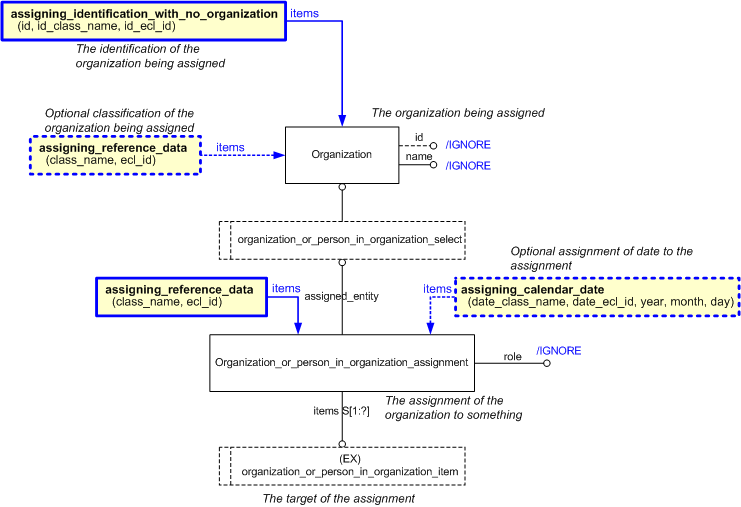
| Capability (C094):— assigning_organization | Date: 2009/02/11 09:52:20 Revision: 1.40 |
This section provides a business level overview of this capability.
An organization can be assigned to an object in a given role. For example, a company can be assigned to a product as the operator of the product.
This section provides an overview of the information model that supports this capability.
The EXPRESS-G for representing the assignment of an organization is shown in Figure 1 below and explained in the following sections.

An organization is represented by the Organization entity and identified by using Identification_assignment to assign an identifier to it. The identifier, such as the name of a company, is stored in the Identification_assignment.identifier attribute.
The type of the identifier, such as a company name or CAGE code, is provided by classifying the Identification_assignment. Where the identifier is a name of an organization, the class, or sub class of, "Organization name" (urn:plcs:rdl:std:Organization name) should be used. Where the identifier is a code for organization, such as a CAGE code, the class, or sub class of, "Organization identification code" (urn:plcs:rdl:std:Organization identification code) should be used.
This approach to identification is described in the capability C001: assigning_identifiers and detailed in the template assigning_identification_with_no_organization.
An example is given in Figure 2 which shows the identification of the 'BikeHire Limited' organization. The identifier is 'BikeHire Limited' which is a name of an organization, hence the Identification_assignment is classified as "Organization name" (urn:plcs:rdl:std:Organization name).
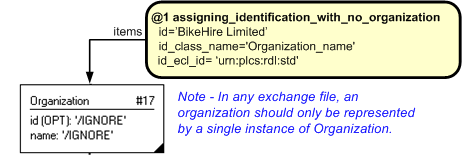
NOTE In any exchange file, an organization should only be represented by a single instance of Organization.
NOTE An organization can have multiple identifiers. For example, a CAGE code, a DUNS code and a company name. This will be represented by a a single instance of Organization with an instance of Identification_assignment assigned for each identifier.
Once the Organization is identified, it can be assigned to an object by an instance of Organization_or_person_in_organization_assignment in a given role. For example, in order to represent an organization having the design authority for a part design, an Organization would be assigned to a Product_as_realized with the role of the assignment being "Design authority". The role of the assignment is provided by using reference data to classify the Organization_or_person_in_organization_assignment. (The assignment of reference data is described in the capability C010: assigning_reference_data).
An example is given in Figure 3 which shows the representation of an organization owning a bicycle. The 'BikeHire Limited' organization is assigned to a bicycle (represented as a Product_as_realized) in the role of "Owner of" (urn:plcs:rdl:std:Owner of).
NOTE See the capability C045: representing_product_as_individual for information on how to represent a realized product.
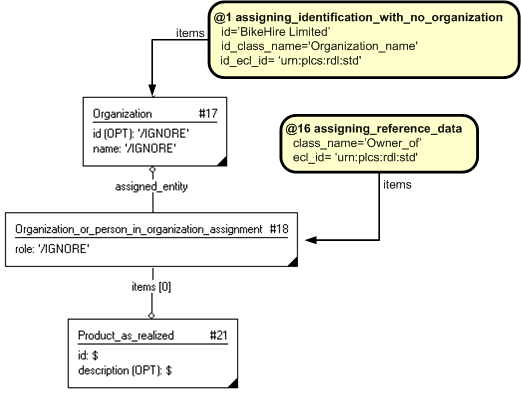
The following templates are instantiated in the diagram:
| Template | Parameters | ||||
|---|---|---|---|---|---|
| @3 | assigning_identification_with_no_organization | items=
#17 |
org_id=
BikeHire Limited |
org_class_name=
Organization_name |
org_ecl_id=
urn:plcs:rdl:std |
| @16 | assigning_reference_data | items=
#18 |
class_name=
Owner_of |
ecl_id=
urn:plcs:rdl:std |
|
This section specifies how the information model can be further characterized by the assignment of additional information such as dates, approvals and people or organizations.
The following characterizations may apply.
Multiple identifications can be assigned to an organization. For example, a CAGE code, a DUNS code and a registered company name.
An organization can be classified by assigning reference data to the Organization entity representing it.
For example, the 'BikeHire Limited' organization can be classified as a 'Bike operator'.
The assignment of reference data is described in the capability C010: assigning_reference_data.
Dates can be associated with the assignment of an organization by using the template assigning_calendar_date. For example, the date on which an organization took ownership of a realized product, and the date on which the organization relinquished ownership is represented by assigning a date to the Organization_or_person_in_organization_assignment.
An example is given in Figure 4 which shows the organization 'BikeHire Limited' owning a bicycle (represented as a Product_as_realized) from 2005-05-12 to 2005-06-12.
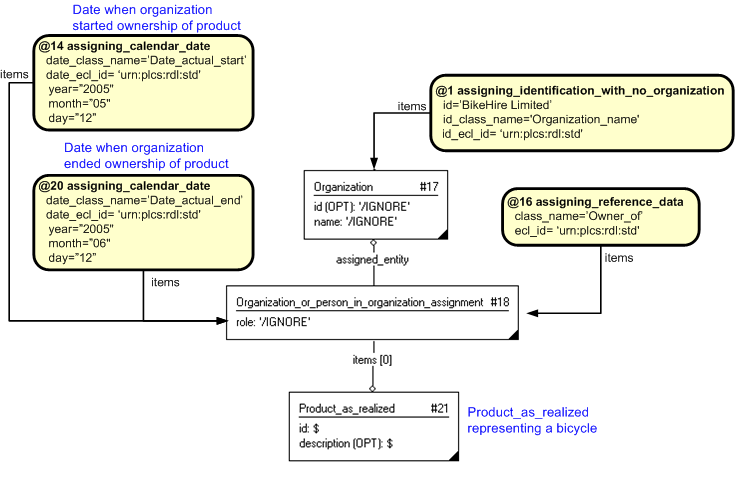
The following templates are instantiated in the diagram:
| Template | Parameters | ||||||
|---|---|---|---|---|---|---|---|
| @14 | assigning_calendar_date | items=
#18 |
date_class_name=
Date_actual_start |
date_ecl_id=
urn:plcs:rdl:std |
year=
2005 |
month=
05 |
day=
12 |
| @20 | assigning_calendar_date | items=
#18 |
date_class_name=
Date_actual_end |
date_ecl_id=
urn:plcs:rdl:std |
year=
2005 |
month=
06 |
day=
12 |
| @1 | assigning_identification_with_no_organization | items=
#17 |
id=
BikeHire Limited |
id_class_name=
Organization_identification_name |
id_ecl_id=
urn:plcs:rdl:std |
||
| @16 | assigning_reference_data | items=
#18 |
class_name=
Owner_of |
ecl_id=
urn:plcs:rdl:std |
|||
The location, such as a geographical location or postal address, of an organization is represented by assigning a location to the organization. The location is represented by Location and Location_representation and then assigned to the Organization by Location_assignment. This is described in the template assigning_location.
NOTE It is also possible to directly assign an Address to an organization using Address_assignment. However, in order to represent the different location representation in a consistent manner, the use of Address_assignment is not recommended. The template assigning_location should be used instead.
The following sections define a set of templates for the capability, where a template is a specification of a set of entities that need to be instantiated to represent a given set of information.
This section specifies the template assigning_organization.
NOTE An explanation of a template and the associated instantiation path is provided in the Template overview section.
NOTE In any exchange file, an organization should only be represented by a single instance of Organization.
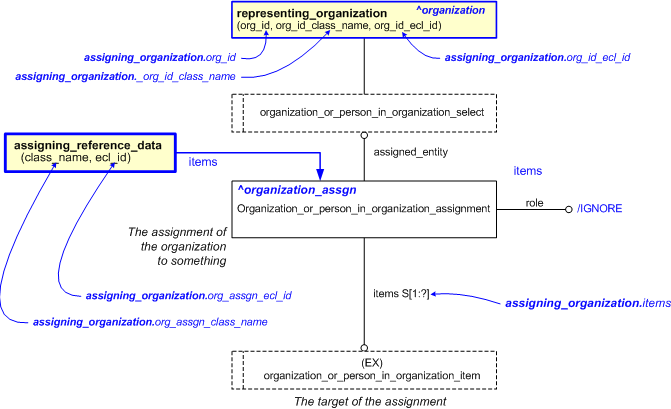

target
is the parameter to which the
Organization
is bound.
target
is the parameter to which the
Organization_or_person_in_organization_assignment
is bound.
| Entity in path | Value | Inherited from |
| Organization_or_person_in_organization_assignment.role | '/IGNORE' | — |
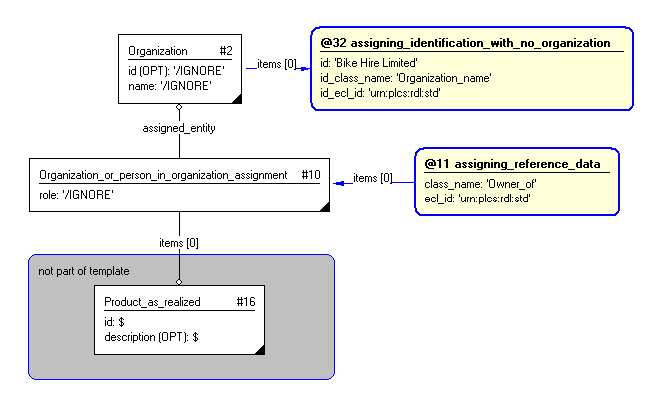
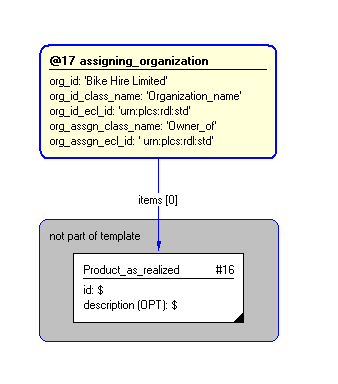
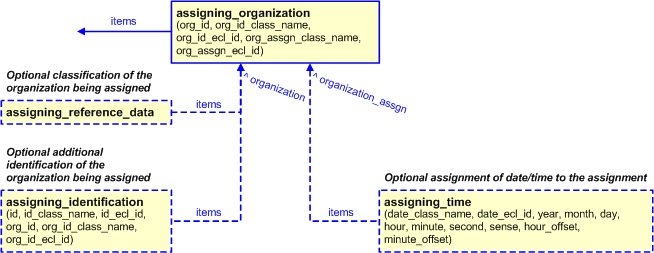
NOTE this characterization is optional.
Multiple identifications can be assigned to an organization.
NOTE this characterization is optional.
An organization can be classified by assigning reference data to the Organization entity representing it.
For example, the 'BikeHire Limited' organization can be classified as an 'Bike operator'.
The assignment of reference data is described in the capability C010: assigning_reference_data.
NOTE this characterization is optional.
Dates and times may be associated with the assignment of an organization by using the template assigning_time. For example, the date on which an organization took ownership of a realized product, and the date at which the organization relinquished ownership is represented by assigning a time to the Organization_or_person_in_organization_assignment.
This section specifies the template representing_organization.
NOTE An explanation of a template and the associated instantiation path is provided in the Template overview section.
This template describes an organization independent of other entities in order to be referenced from other templates.
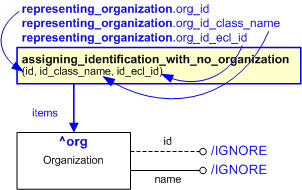

target
is the parameter to which the
Organization
is bound.
| Entity in path | Value | Inherited from |
| Organization.name | '/IGNORE' | — |
| Organization.id | '/IGNORE' | — |
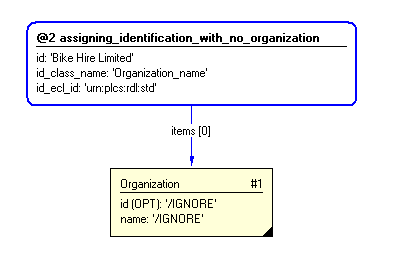
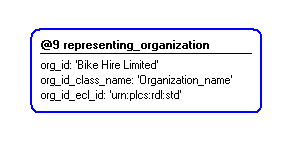
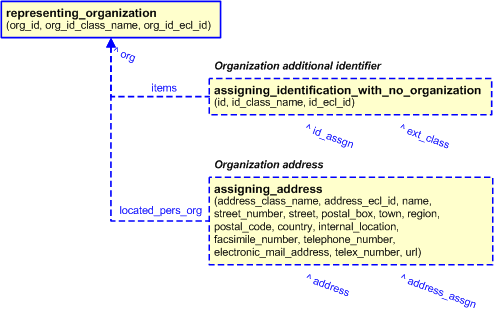
NOTE this characterization is optional.
Organization may have optional identifiers.
The Organization may have two identifiers (id and name) instead of either or. This may be represented by using the template assigning_identification_with_no_organization to assign a name or identifier to an Organization.
NOTE this characterization is optional.
An address may be assigned to an organization, e.g. to provide contact information.
The address of an organization is represented using the template assigning_address to assign an address to an Organization. This is illustrated in Figure 5
This section specifies the template representing_organization_relationship.
NOTE An explanation of a template and the associated instantiation path is provided in the Template overview section.
This template describes how to represent a relationship between two organizations.
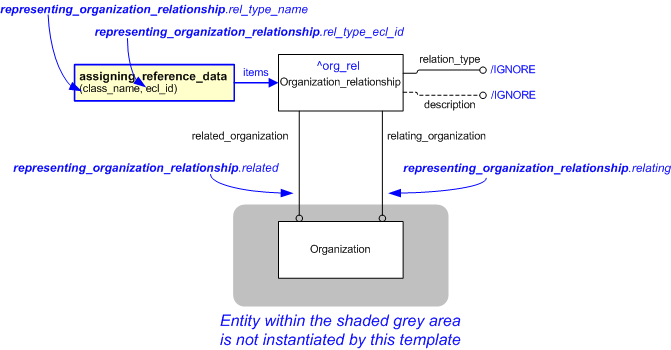

target
is the parameter to which the
Organization_relationship
is bound.
| Entity in path | Value | Inherited from |
| Organization_relationship.relation_type | '/IGNORE' | — |
| Organization_relationship.description | '/IGNORE' | — |
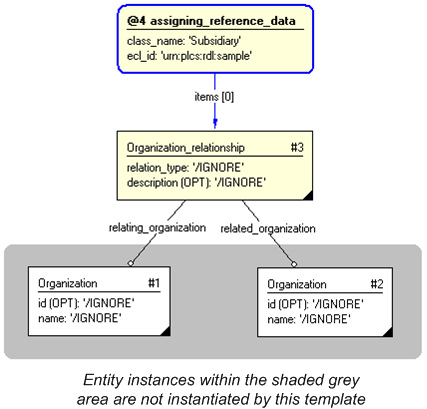
#1 = ORGANIZATION('/IGNORE','/IGNORE'); #2 = ORGANIZATION('/IGNORE','/IGNORE'); #3 = ORGANIZATION_RELATIONSHIP('/IGNORE','/IGNORE',#1,#2); #5 = CLASSIFICATION_ASSIGNMENT(#6,(#3),'/IGNORE'); #6 = EXTERNAL_CLASS('/NULL','Subsidiary','/IGNORE',#7); #7 = EXTERNAL_CLASS_LIBRARY('urn:plcs:rdl:sample','/IGNORE');
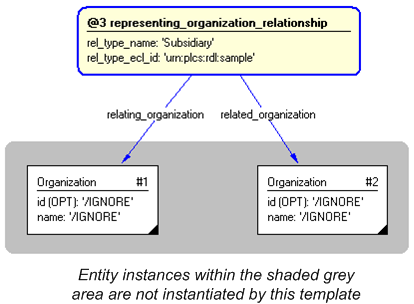
This capability "Assigning an organization" is dependent on the following capabilities:
The following classes of reference data are required for this capability:
© OASIS 2010 — All rights reserved